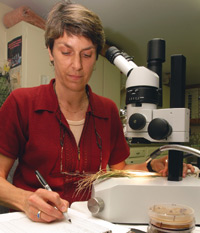| Plant
Diagnostic Network Targets Biosecurity
downloadable
pdf
To
help protect agriculture from terrorism, the University
of Florida is one of five land-grant universities in
the nation coordinating a new National Plant Diagnostic
Network that will provide an early warning about pests
and diseases.
 |
| Gail
Wisler, professor and chair of UF’s plant
pathology department, is director of the Southern
Plant Diagnostic Network, which includes 12 southern
states and one U.S. territory, and is part of a
national network that can quickly detect, diagnose
and respond to intentional and accidental introductions
of plant pests and pathogens. |
“Agriculture
is an inviting target for terrorists,” said Gail
Wisler, a professor and chair of the plant pathology
department in UF’s Institute of Food and Agricultural
Sciences (IFAS). “It’s also a ‘soft’
target because it covers an enormous amount of land
under decentralized management and would have a significant
economic impact.”
She
said few sights would be more demoralizing to people
than crop fields ruined by disease or pestilence, or
livestock herds led to mass slaughter. She said it’s
critical to have the ability to quickly detect, diagnose
and respond to intentional and accidental introductions
of plant pests and pathogens.
Wisler,
who is coordinator of a regional network that serves
12 southern states and one U.S. territory, said a $900,000
homeland security grant from the U.S. Department of
Agriculture (USDA) provides initial funding for the
program. The Southern Plant Diagnostic Network, which
is part of the national network, includes Alabama, Arkansas,
Florida, Georgia, Kentucky, Louisiana, Mississippi,
North Carolina, South Carolina,
Tennessee, Texas, Virginia and Puerto Rico.
The
national network comprises four regional networks in
addition to the southern network. Universities coordinating
other regional networks include Cornell University for
the Northeast, Michigan State University for the Midwest,
Kansas State University for the Great Plains and University
of California at Davis for the West.
“UF
has a long and trusted relationship with those involved
in food production, and our statewide research and extension
programs interact closely and rapidly with growers,”
Wisler said. “It makes good sense to capitalize
on our well-equipped plant pest and diagnostic labs
and staff of plant scientists with vast experience in
integrated pest management.”
Wisler
said the USDA-sponsored national network is developing
a Web-based plant pest diagnostic and reporting system,
that will help faculty and staff at UF and other land-grant
institutions submit plant samples, digital images and
detailed crop information for pest diagnosis.
She
said the state and national networks also will establish
a “first detector” system to help monitor
the introduction of new plant pests or unusual pest
outbreaks.
“First
detectors are an integral part of the system and include
growers, county extension faculty, state agriculture
department personnel, crop consultants, pesticide applicators,
and commercial chemical and seed representatives,”
Wisler said.
“Federal
and state agencies monitor U.S. borders for plant pest
introductions and watch for pest outbreaks throughout
the nation. Still, new pests often are first detected
by those involved in crop production and are identified
by professionals at land-grant universities and
state labs.”
Gail
Wisler, gcwisler@mail.ifas.ufl.edu
by
Chuck Woods
|


